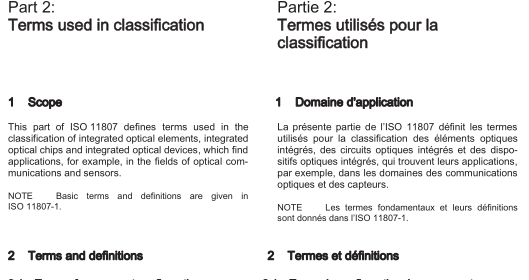BS EN ISO 11807-2:2005 – Integrated optics — Vocabulary — Part 2: Terms used in classification

stn5
1 Scope
This part of ISO 11807 defines terms used in theclassification of integrated optical elements, integratedoptical chips and integrated opticall devices, which findapplicationis. for example. in the fields of opticall com-munications and sensors.
NOTE_Basic termsan ISO11B07-1.
Terms and defintions
2.1Typos of component configuration
2.1.1
integrated opticall element
opticall element which performs a basic function of in-tegrated optics
See Figure 1.
2.1.2
integrated opticall chip
monolithic unit which contains at least one integratedoptical element
See Figure 1.2.1.3
infegrated opticall device
packaged integrated optical chip
NOTE The packaging may consist at a minimum ofone optical linput andVor output connection and/or electricallconneclions andlor a housing-
See Figure 1.
2.2 Types of functlion
NOTE The types of function defined here are specilied for elements, whereby they are valid for all orresponding component configurations.
2.2.1 passive integrated optical element element based on the principle of waveguiding and radiation interference, respectivaly, without extermal influence on the refractive index and ftted exclusively with optical inputs and outputs
NOTE This element is employed for changing the direction, distribuing, combining, transformi ng and fitring of gulded radlation waves.
2.2.2 contollable integrated optical element element which can be influenced by various physical effects [eg. electro-optical, acousto-optical, piezooptical,thermo-opic or electro-absorptive material characteristics which can be used to change the (complex) refractive index]
NOTE In the case of electro-optical control, the refractive index can be changed by the penetration of an eloctic field, or acousto-optical control by a surface acoustic wave (SAW).
BS EN ISO 11807-2:2005 – Integrated optics — Vocabulary — Part 2: Terms used in classification